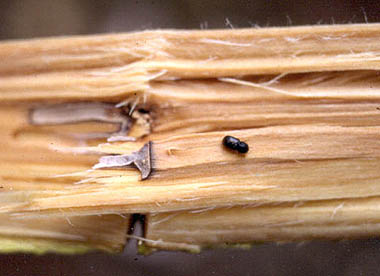|
|
||||||
 |
||||||
|
|
|
|
|
|
||
Ambrosia BeetlesHostsMany native and ornamental deciduous trees and fruit trees (apple, cherry and prune), especially adjacent to forests; rarely conifers.DamageLeaves - Sudden wilting and death; delayed emergence in spring.Branches - 1.5 mm-wide tunnels through bark into heartwood (shothole borer does not tunnel into wood) in a circular or cork-screw pattern with the rings; wood shows purple stain extending from tunnels due to fungus released by the adult beetles. Severely infested branches can break easily due to gusty winds or fruit load. Trunk - Tunneling into trunks of young trees can weaken trunks to the point they can break.
IdentificationLarva - White, legless, slightly curved, up to 4 mm long.Adult female- Dark reddish-brown beetle about 3 mm long. Adult male - Wingless beetle about 1.5 mm long. Life HistoryAmbrosia beetles overwinter as adults within galleries in the heartwood. Adults emerge in April and fly to new trees where the females bore tunnels in which they lay their eggs. Larvae feed on ambrosia fungus growing in the tunnels. There is one generation per year.MonitoringSticky material on tree trunks may help detect adults. Use ethanol-baited funnel traps to monitor adults in the spring. Sawdust at the entry of tunnels indicates recent attacks by adults.ControlCultural - It is important to maintain optimum tree vigor as ambrosia beetles are attracted to trees weakened due to drought, flooding, transplanting, disease, winter injury and mechanical injury. Do not store wood with bark near orchards as it can remain a source of ambrosia beetles for up to a year. Remove and promptly burn or chip beetle-infested trees or limbs. If the wood cannot be burned, chipped or otherwise destroyed, cover the wood with plastic to prevent beetles from attacking the wood or escaping if already infested. To intercept female beetles as they fly into an orchard (males do not fly), place bundles of three or four 1- to 2-metre long hardwood logs (harvested the previous year) at 10-20 metre intervals along borders adjacent to deciduous (hardwood) trees. Puncture the bark several times to improve release of odors attractive to the beetles. Destroy the trap logs before new adults appear.Chemical - Endosulfan (Thiodan or Endosulfan) applied for control of aphids in the spring will also control any active adult beetles. March 200 6
Return to Tree Fruit Pests and Diseases
|
|||||
|
|
|||||
